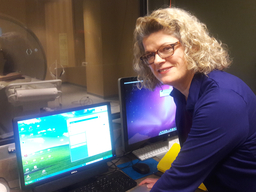CIRCA Presents: Eric Dyer & Lynn Watson
CIRCA Fellowship Talks
Location
Performing Arts & Humanities Building : 216
Date & Time
April 25, 2018, 12:00 pm – 1:00 pm
Description
Eric Dyer is an artist and educator who brings animation into the physical world with his sequential images, sculptures, and installations. He spent years working at a computer to produce images for the screen. Longing to “get my hands back on the work,” Dyer returned to a tactile creative process. He began exploring the zoetrope, an early form of animation. The device, popular in the 19th century, consists of a slitted drum whose interior is lined with a sequence of images. When the object is spun, the viewer peers through the apertures in the drum and the forms appear to move. By replacing the drum with a fast-shutter digital video camera, Dyer invented the process of making films from spinning sculptures. Dyer continues to innovate with new tools and applications, moving his work off the screen and into real spaces.
